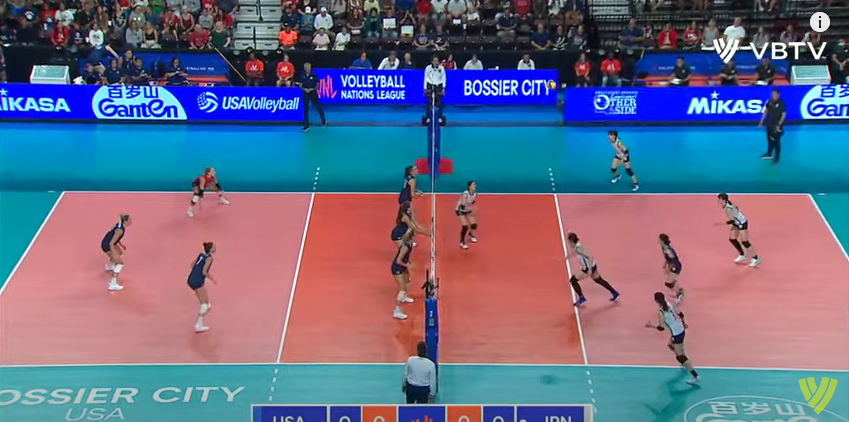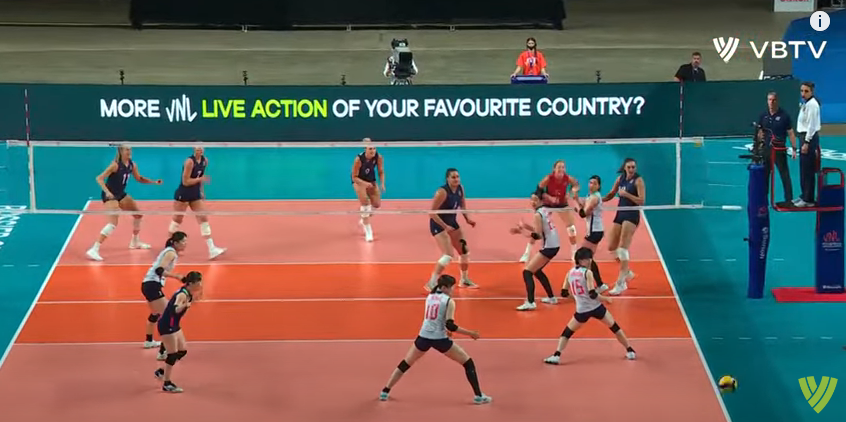In the world of volleyball, the game starts with a powerful serve over the net. A ball and sport in which two teams of six players compete against each other in a game area separated by a central net. The goal of the game is to pass the ball over the net and onto the opponent’s field while the opposition team tries to stop you from doing so, leading you to miss. An attack phase occurs when one team attempts to get the ball to touch the opposite field’s ground, while a defense phase occurs when the other team attempts to prevent it.
Clean hits must be used to touch or propel the ball, but it cannot be stopped, held, or accompanied. The ball is generally hit with hands and arms, and each side has a maximum of three touches to return the ball to the other field (in addition to the blocking contact). Ball contact with any part of the body, including the feet, has been permitted for some years. Volleyball players must shift positions when they score points, which is one of the most unusual aspects of the game.

The Strategy of the Game
Attack Systems
In volleyball, having an attack attitude is natural because success is earned through attacking. Volleyball’s assault is the most important factor, yet the game’s rules are constantly being changed to compensate for this imbalance.
A team consists of players who can be a:
- Setter: the player in charge of the second pass, often known as the attack construction pass.
- The auctioneer is the player in charge of the auction or third contact. A player who can play both the setter and spiker positions.
- A Libero is a player that only plays in the back zones and is unable to shoot, serve, or place in the front.
The 5-1 offensive strategy
is currently the most popular and is used by most teams who have mastered a certain method. There are five possible spikers and one setter. This strategy assumes a major imbalance between the six rotations because three of them will have three forward attackers, while the other three will have only two. The main reason for employing this approach in groups is that it takes less time to train. In the event of a 6-2, the training work with the setter and the coordination of each setter with the spikers would have to be doubled. Training time is a critical component of any team’s tactical development.
The 4-2 offensive system
consists of four spikers and two setters. When one of the setters leaves the front area to become a defender, his opposite enters as a forward, ensuring that one of the two setters is always available to perform the role of setter. The setter will start in zone 3 and then move to zone 2, leaving the tall shooters to occupy the centre of the net. This is the most basic system and the one that should be used in any initiation.
Assisting the receptionists
Receiving serve formations have evolved in recent years. In men’s volleyball, all teams receive using a similar system; the basic formation is two receivers (one the libero) if the serve does not have a leap, and three (one the libero) if the serve does. The feminine, on the other hand, has more variety, with reception formations of 5, 4, 3, and 2 players.
Defensive Systems
They are usually used on the K-2 in response to a spike that ends the K-1. The K-1 attacker has an easy time winning. The defenders of the first and second row have to be very aggressive since it is very difficult to cover the 81 square metres of the field well. Defence must start at the net, at the front line. Three blockers are available, while the opponent can attack with a larger number. An aggressive and intimidating screen should be interposed in such a way that the ball can be sent to the ground of the opponent or allow the ball to be cushioned in the screen to generate a counter attack. A high position should be adopted, offering the contact zone in the block as soon as possible.

Basic Fundamentals of the Play
Serve
For the serve or serve, a player makes a long jump. The jump makes it easier to cross the net and hit harder because the hit may be done higher. A throw-in from behind the baseline starts each point. The ball is launched into the air and hit toward the opposing field in search of weak spots in the opponent’s receiver. It can be done while standing or while jumping. The serve’s orientation is critical because the opposing player, who is compelled to receive the shot, is limited in his or her ability to participate in the ensuing attack. The right back player must stand in the service area and wait for the referee’s whistle to sound before making the gesture.
Reception
Intercepting and controlling the ball coming from the opposite team’s serve is called reception. In volleyball, receiving the serve is a crucial skill that must be practised extensively until it is perfected. Aside from the technical challenge of countering the ball’s force, the pass that results from this reception must have precise control and direction towards a specific location, ensuring a good attack to get the point. As a result, this blow requires extreme precision, and the most common gesture for doing so is the forearm pass.
Placement
The second touch is usually designed to place the ball in the best possible condition so that the auctioneer may eventually place it in the opposite field with the third touch. Setting is accomplished by elevating the hands and passing with a finger pass, which is the most precise pass in volleyball. The setter is responsible for distributing the balls throughout the game, to the various spikers, and through the various zones.
Blocking
This action sought to intercept any opposing team attack by jumping adjacent to the net with raised arms in the hopes of returning the ball directly to the opposing field, or if that wasn’t possible, narrowing the field of attack to force it to throw the ball out of play. To improve interception possibilities, up to three players (all three forwards) can block. In the event of a botched block, the second row’s assistance in recovering the ball will be crucial. One of the alternatives available to the jumping attacker is to throw the ball hard against the block, forcing a miss and resulting foul.
Defending
It is the activity taken on by the players after the ball hits or passes the screen’s line, covering the regions of the field that remain free beyond the screen’s shadow. It’s common to see a player get into a plank on his stomach and stretch his arm so that the ball bounces off his hand instead of the ground, avoiding the point, or using alternate techniques with one arm, including falling even with his foot, to retrieve balls travelling to the free zone.
Volleyball positions determine the players’ roles on the court, contributing to the team’s success.
Betting FAQs
What is the most important technique in volleyball?
There is no one technique that is the most important in volleyball. However, there are some techniques that are more important than others.
Some of the most important skills in volleyball include spiking, passing, setting, blocking and serving. There are many other skills as well but these five are among the most important.
How many types of main techniques are there in volleyball?
There are five main techniques in volleyball:
The first technique is the bump. This technique involves a player hitting the ball with their hands and then pushing it up over the net. The second technique is the set. This technique involves a player hitting the ball with their hands and then letting it bounce once on the ground before making contact with it again. The third technique is the hit-set. This technique involves a player hitting the ball with their hands and then letting it bounce once on the ground before making contact with it again. The fourth technique is called spiking, which is when a player hits an overhand pass to make contact with an opponent’s hand or arm that is holding up to block them from doing so. The fifth and last main volleyball techniques are blocking, which happens when one of your teammates pushes your opponent’s arm or hand that they are using to try to make contact with you, or when you push your opponent’s arm or hand that they are using to try to make.
What are the 5 volleyball strategies and plays for tipping the ball for points?
There are 5 volleyball strategies and plays for tipping the ball for points. These include the Spike, Block, Smash, Tip, and Lob.
A spike is a volleyball technique that involves a player jumping and hitting the ball with their arm on their downward trajectory. It is usually used to attack an opponent’s set or to win a point in an individual rally. A block is a defensive technique where a player tries to stop or slow down the movement of an opponent’s shot by placing their hands in front of the ball. A smash is another defensive technique where players hit overarm shots with maximum force into their opponents court in order to score points or disrupt play. A tip is when players touch the ball lightly so that it falls into their opponents court without them having to hit it hard enough for it to go over the net. Lastly, lobs are essentially high-arcing serves that bounce off of one side of the net onto another side before landing in their opponents court.
The key to dominating volleyball positions lies in mastering techniques like setting, spiking, and blocking the ball.
Visit PIWI247 to learn more about volleyball and all other sports available on our website and learn more about PIWI247 Sports Powered by Pinnacle Sports.
Klemens Kamiński
Interest in Esports. Wanted to try writing for different platforms. He is a 38-year-old who enjoys playing soccer, mountain climbing, and charity work. He mostly travels to games and investigates current events in sports. Follow him on Quora today.
